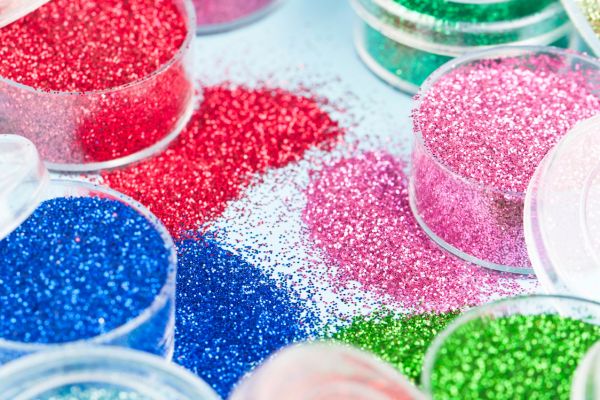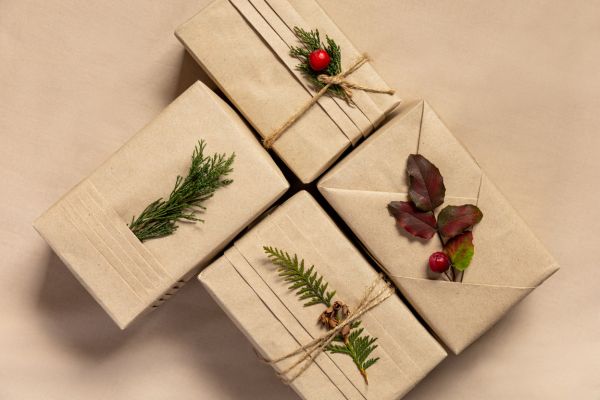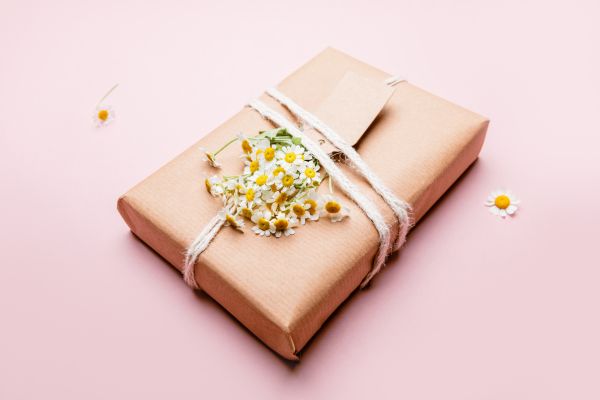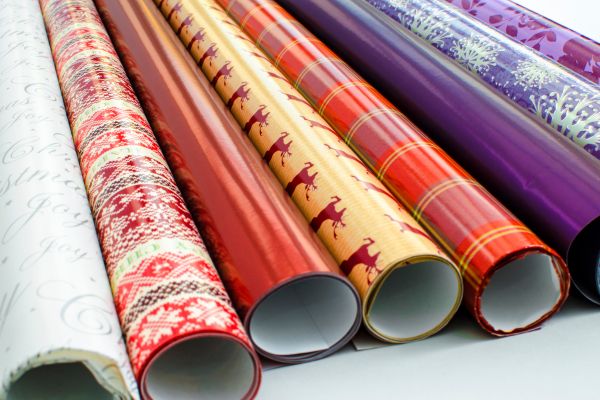Have you ever wondered is gift wrap recyclable? We often think that gift wrapping is all paper, and therefore that it’s recyclable, but unfortunately, not all wrapping paper is created from plain paper. As with many items in our lives, a lot of the gift wrapping we use is actually made of plastic or has plastic embellishments attached to it.
Understanding the difference can help lower your impact on the environment and reduce how much waste you create. Here’s a quick rundown on recycling gift wrapping for you.
Is Gift Wrap Recyclable?
Yes, gift wrap can be recyclable, but there’s a catch. Some types are definitely not recyclable.
Wrapping paper that is recyclable tends to be made from paper and not plastic and has no embellishments.
Types of gift wrapping that can be recycled include:
- Gift wraps that are made from kraft paper or newsprint, usually with a matte finish. Note that additional decorations like ribbons or bows must be removed before recycling.
- Recycled gift wrap made from recycled paper materials such as cardboard, these wrapping papers can be recycled again.
Always check your local rules on what is accepted before putting items into your curbside recycling bin. If you want to learn more about curbside recycling, try our conquer curbside recycling challenge.
Gift wraps that are not recyclable include:
- Shiny, laminated gift wraps or those bedazzled with glitter and metallic shapes.
- Wrapping paper that’s thin and lacking good quality fibers.
- Gift wraps with foil, plastic, ribbons, and bows stuck to them.
Other Gift Wrapping Materials That Are Not Recyclable
Gift wrapping is not just about the paper. Many other materials can be used to wrap gifts like ribbons, bows, and glitter. Unfortunately, these materials cannot be recycled.
- Bows – Bows aren’t recyclable due to their mixed material composition and the presence of glue. Discarded bows can obstruct recycling equipment functioning. Instead of recycling, reusing bows is the best option, or consider decorative items from nature like pinecones and dried flowers.
- Ribbons and twines – Typically, ribbons and twines are made of polyester or nylon, both forms of plastic. These materials cannot be recycled in curbside recycling programs. They get tangled in the sorting equipment, causing major headaches. Seek alternatives such as compostable materials like hemp, jute, and Raffia ribbons or natural materials like fallen pinecones or eucalyptus branches.
- Glitter – That sparkly, glittery wrapping paper you love is actually not recyclable. In fact, it is much worse. You see, glitter is made of tiny bits of plastic. These little shreds are all too easily separated from the paper during use and will likely end up as microplastics polluting the environment. Glitter is actually referred to as a primary microplastic because it is manufactured to be smaller than 5 millimeters. Therefore I would recommend you avoid glitter altogether, even paper with glitter embellishments. Consider those tiny shiny pieces are just as attractive to an animal as us, but unfortunately, they are more likely to ingest the plastic than just appreciate it.

So remember, opt for plain, recyclable wrapping paper or look for other eco-friendly options. Below I provide many tips and ideas for you to try.
How To Tell If Your Wrapping Paper Is Recyclable?
1. Find Out if Your Local Recycling Facility Accepts Gift Wrap
As I always say, the first step is to check with your local curbside program to understand what they accept. Most will accept paper, but some may exclude wrapping paper because it’s too hard for them to check whether it’s plastic or paper once it arrives at the facility.
The most important thing to do is to check if the wrapping paper is plastic or plain paper. So how can you tell the difference?
There are a few things you can do to figure out if your wrapping is plastic or paper.
- Step 1: Do the ‘scrunch test’. Crunch the material into a ball. If it keeps its shape, it’s most likely paper and is recyclable. If it bounces back, it’s more likely to be plastic or plastic-coated paper and is not recyclable.
- Step 2: Look for metallic or shiny finishes. Those are a no-go and cannot be recycled.
A pro tip: if you’re still unsure, it’s best to play it safe. Rather than risk contaminating your recycling, dispose of it in the regular trash or consider reusing it.
The best place to do these test is at the store before you buy the wrapping paper. I’m not suggesting you scrunch up wrapping paper that you haven’t paid for yet but you can check the label to see it says what it is made from. If it is unclear then perhaps look at other options. And remember to avoid any type of paper with glitter on it.
Eco-Friendly Gift Wrap Options
Reduce the Amount of Wrapping Paper You Use
Here are some great tips on how to reduce the amount of wrapping paper you use or at least convert to more recyclable or eco-friendly options.
- Swap virgin fiber paper for 100% recycled wrapping paper, or you could even use newspaper.
- Reuse your wrapping paper. Open your gifts carefully, keeping the wrap intact for future use. Stanford University notes that using recycled materials for just three gifts can help cover 45,000 football fields!
- Choose non-traditional wrapping. Keep an eye out at vintage stores for finds like old paper items like maps or posters, or you could use scarves or old totes.
- Gift tins, bottles, and boxes are the perfect items to recycle. They are popular, can withstand multiple uses, and are made from materials like metal, glass or cardboard that are easy to recycle into new products.
Use Creative Alternatives to Wrapping Paper
Here are some creative ways you can use less wrapping paper:
- Fabric Wraps: Why not give your gifts a unique touch with fabric scraps, handkerchiefs, or even canvas bags? Switch up your gift-wrapping routine with cloth! It’s a creative and eco-friendly way to dress up your presents with the bonus of reduced waste. They look lovely, and they’re sustainable! Be sure to use items you already have or buy them from a second-hand store. Buying new fabric, especially for wrapping presents, is not very helpful in reducing waste overall unless you wrap things in teatowels or scarves that form part of the gift.
- Repurposed Paper: Give old newspapers, posters, maps, or your kids’ artwork a new lease on life as unique, eco-friendly wrapping!
- Use natural embellishments: Nature provides many things, including natural embellishments that can be used to give a gift a beautiful look.
- Go naked: Why not avoid gift wrapping altogether? You can even be creative and send your kids on a gift scavenger hunt around the home to replace the fun of unwrapping the gift.
So, there you have it! Each choice helps reduce waste and adds a creative edge to your gift-giving.


Set up a Wrapping Paper Community Share Program
A Wrapping Paper Community Share Program is a fun initiative to reduce the waste of gift wraps, especially during holidays. Recycling, reusing, or sharing wrapping materials can save a large amount of gift-wrapping materials from ending up in the trash!
How to get started organizing a Wrapping Paper Share Program in your community:
- Organize a Share-the-Wrap meetup: Invite friends, family, or community members to bring their leftover wrapping materials – ribbons, wrapping paper, boxes, and so on.
- Set up Trading Stations: Arrange these items in different sections so everyone can easily find what they need.
- Barter, Swap, or Share: Encourage attendees to trade materials for what they need. Remember, one person’s trash can be another’s treasure!
- Conduct a DIY Workshop: Show how to make unique designs using old wrapping papers or even using fabric or other materials.
- Encourage to BYOB (Bring Your Own Bag): So participants can bring their chosen items home.
This fun event not only makes wrapping more sustainable but also builds a sense of community. So, start your Wrapping Paper Community Share Program today and make a difference together!
Want more tips on recycling common items?
Now you know the answer to “Is Gift Wrapping Recyclable?” and have discovered plenty of ways to choose more recyclable wrapping paper. If you are interested in more tips on recycling common items, take a look at some of these articles:
- Recycling your old Christmas Lights – Got old Christmas lights lying around, and you’re unsure what to do with them? Don’t chuck them in your recycling bin; they can clog up recycling machinery. Instead, head to our article on recycling your Christmas lights responsibly.
- How to Dispose of Carpets: A Guide for Recycling Old Carpets
- Can You Recycle Bottle Caps? Learn How to Recycle Bottle Lids and Caps
- Can You Recycle Pots and Pans?














